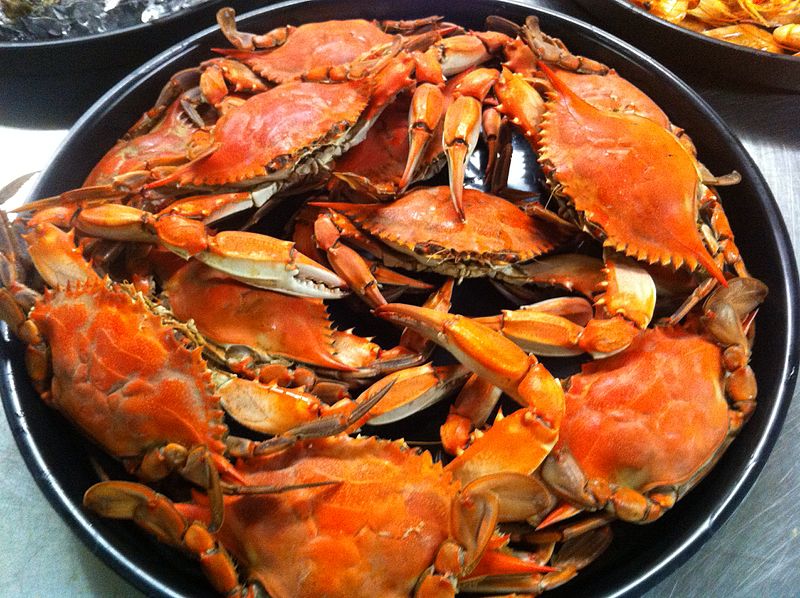Summertime means lots of fresh seafood. Always a favorite, crab practically screams for Old Bay Seasoning. But it wasn’t always that way. Old Bay Seasoning is the brainchild of Gustav Brunn, an immigrant from Germany who settled in Baltimore on the Chesapeake Bay where crab is practically a way of life. He perfected his recipe in 1939 and it became a hit. It was purchased by McCormick & Co. in 1990. That company expanded its use from seafood to include chicken, hamburgers, French fries, popcorn and baked potatoes. No matter how you use it, it’s fun to try to make your own.
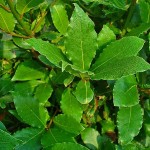 Bay Laurel – Bay leaves come from a tree, that properly maintained can be grown in a container. A little judicious root pruning, as well as top pruning, keeps it to a manageable size. Native to the Mediterranean, it likes to be dry so avoid overwatering it. It prefers full sun but will tolerate a little shade making it easier to overwinter it indoors for those of us who live north of zone 8. The leaves can be harvested any time and are easy to dry.
Bay Laurel – Bay leaves come from a tree, that properly maintained can be grown in a container. A little judicious root pruning, as well as top pruning, keeps it to a manageable size. Native to the Mediterranean, it likes to be dry so avoid overwatering it. It prefers full sun but will tolerate a little shade making it easier to overwinter it indoors for those of us who live north of zone 8. The leaves can be harvested any time and are easy to dry.
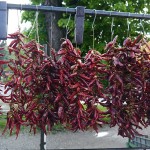 Paprika – Paprika is just dried, ground chili peppers. Chili peppers like heat so it’s best to hold off planting them in your garden until the soil has reached 65⁰F and the nights are above 55⁰F. Make sure they have full sun and the soil stays evenly moist. The peppers are ready to harvest when they have turned red, orange, yellow or purple, depending on the variety. They can be air dried or you can use a food dehydrator. Grind up the dried peppers and you have paprika.
Paprika – Paprika is just dried, ground chili peppers. Chili peppers like heat so it’s best to hold off planting them in your garden until the soil has reached 65⁰F and the nights are above 55⁰F. Make sure they have full sun and the soil stays evenly moist. The peppers are ready to harvest when they have turned red, orange, yellow or purple, depending on the variety. They can be air dried or you can use a food dehydrator. Grind up the dried peppers and you have paprika.
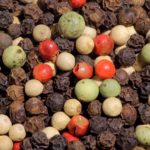 Black Pepper – Black peppercorns are the fruit of pepper vines which are native to India but are now grown throughout the tropics. If you live in a temperate zone and plan to grow a pepper vine in a container, be sure to include some kind of support for it climb on. Peppercorns start out green and ripen into red. To get black peppercorns, the fruit is harvested while it is still green and then dried. The green outer skin turns black when dried.
Black Pepper – Black peppercorns are the fruit of pepper vines which are native to India but are now grown throughout the tropics. If you live in a temperate zone and plan to grow a pepper vine in a container, be sure to include some kind of support for it climb on. Peppercorns start out green and ripen into red. To get black peppercorns, the fruit is harvested while it is still green and then dried. The green outer skin turns black when dried.
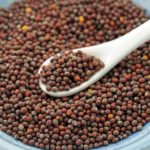 Mustard Seed – The familiar condiment, mustard, is a combination of mustard seeds, water and an acid such as wine or vinegar. The seeds can come from three different types of mustard plants, all members of the brassica family which includes cabbages, cauliflower and broccoli. The plants are cool season plants so the seeds are sown early in the spring. The seed pods should be harvested as soon as they start to turn from green to brown. They can then be dried until they turn completely brown.
Mustard Seed – The familiar condiment, mustard, is a combination of mustard seeds, water and an acid such as wine or vinegar. The seeds can come from three different types of mustard plants, all members of the brassica family which includes cabbages, cauliflower and broccoli. The plants are cool season plants so the seeds are sown early in the spring. The seed pods should be harvested as soon as they start to turn from green to brown. They can then be dried until they turn completely brown.
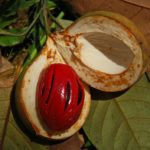
Mace – Mace is the seed covering, called the aril, of the nutmeg tree seed. The seed is the spice nutmeg. The nutmeg tree takes 5 to 8 years before it is old enough to bear fruit. The fruit is yellow and looks similar to apricots. When the fruit ripens, it splits open revealing the aril covered seeds inside. The aril is scarlet and the seeds are a purple brown. Unlike bay laurel trees which can be grown in containers outside of its native habitat, nutmeg trees can only grow in very specific habitats and not suitable for growing in containers.
 Cinnamon – Cinnamon is a spice that is harvested from the bark of cinnamon trees which are tropical. Cinnamon trees are not as picky about their environment like nutmeg trees and they are slow growing so you can grow one in a container. The bark used is young bark which can be easily peeled away from the branch and dried.
Cinnamon – Cinnamon is a spice that is harvested from the bark of cinnamon trees which are tropical. Cinnamon trees are not as picky about their environment like nutmeg trees and they are slow growing so you can grow one in a container. The bark used is young bark which can be easily peeled away from the branch and dried.
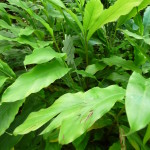
Cardamom – The plants are grown from rhizomes but it is the seeds that are used as spice. They are tropical plants. You can grow cardamom from seeds in a container. Be sure to use fresh seed. It is only viable for two years. You can begin harvesting the pods in the fall when the flowers have dried out and the pods turn green. Dry the pods on screens for 6 or 7 days, turning them frequently. Once the pods are dry, the seeds are ready to be harvested. Because the seeds lose their freshness and flavor very quickly, they should be stored in their dried pods until they are used. If you are using them ground, delay grinding the seeds until you are ready to use them.
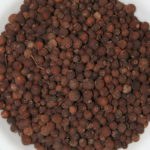 Allspice – Allspice is made from the dried, unripened berries of the allspice tree. It is called allspice because the flavor is a combination of ginger, nutmeg and cloves. Native to the tropics, the trees can be grown in containers and brought indoors during the winter. Small white flowers appear in the spring followed by dark purple berries in the summer. The berries are harvested when they are green before they ripen to purple. Traditionally, they are dried in the sun. When dried, they are brown, resembling peppercorns. Once the dried berries are ground, they begin to lose their flavor so it is a good idea to grind the berries only when you need them.
Allspice – Allspice is made from the dried, unripened berries of the allspice tree. It is called allspice because the flavor is a combination of ginger, nutmeg and cloves. Native to the tropics, the trees can be grown in containers and brought indoors during the winter. Small white flowers appear in the spring followed by dark purple berries in the summer. The berries are harvested when they are green before they ripen to purple. Traditionally, they are dried in the sun. When dried, they are brown, resembling peppercorns. Once the dried berries are ground, they begin to lose their flavor so it is a good idea to grind the berries only when you need them.
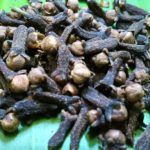 Cloves – Cloves are the dried flower buds of clove trees which are native to the tropics. They are not suitable for growing in containers because they require lots of humidity and large amounts of rainfall, between 50 and 70 inches each year. Buy your cloves whole and grind them as you need them.
Cloves – Cloves are the dried flower buds of clove trees which are native to the tropics. They are not suitable for growing in containers because they require lots of humidity and large amounts of rainfall, between 50 and 70 inches each year. Buy your cloves whole and grind them as you need them.
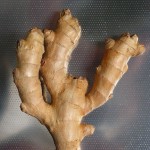
Ginger – Hardy only in zones 9 through 12, ginger has a long growing season, 10 months to maturity, so you will need to start it in a container indoors, put it outside during the summer and then bring it back in in the fall. The root is ready to be harvested when the foliage starts to die back in the fall. The root can be dried and then ground as needed.
To make your Copycat Old Bay Seasoning, you will need to dry and grind all of your spices, including the bay leaves. You can use a mortar and pestle, a spice grinder or, if cleaned carefully afterwards, you can simply use your coffee grinder.
Combine your ingredients as follows:
• 1 Tbsp. Celery Salt
• 1/4 tsp. Paprika
• 1/8 tsp. Ground Black Peppercorns
• 1/8 tsp. Ground Cayenne Pepper
• Pinch Ground Mustard Seed
• Pinch Ground Mace
• Pinch Ground Cinnamon
• Pinch Ground Cardamom
• Pinch Ground Allspice
• Pinch Ground Clove
More Herb Blends
Bouquet Garni
Chinese Five Spice Blend
Curry Blend
Fines Herbes
Herbes de Provence
Italian Seasoning
Paprika
Poultry Seasoning
Za’atar

